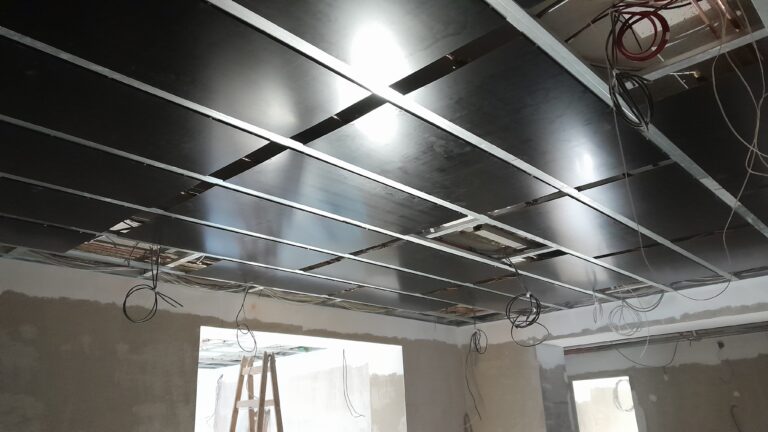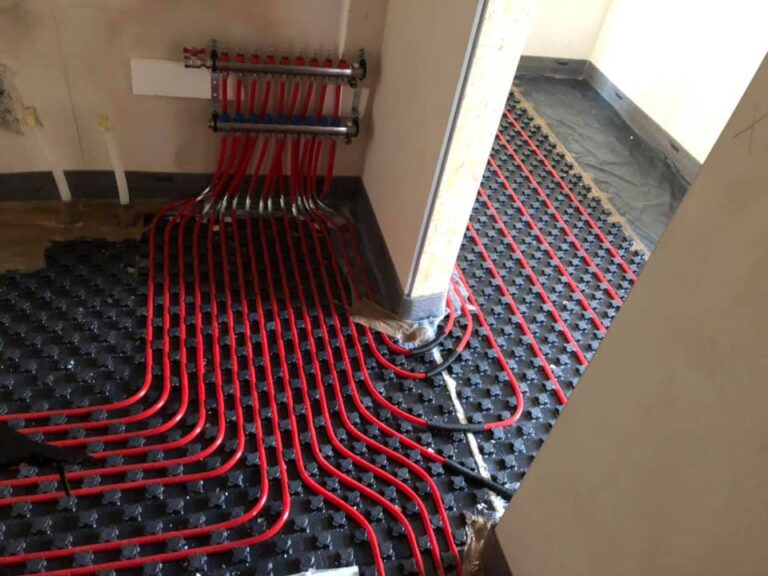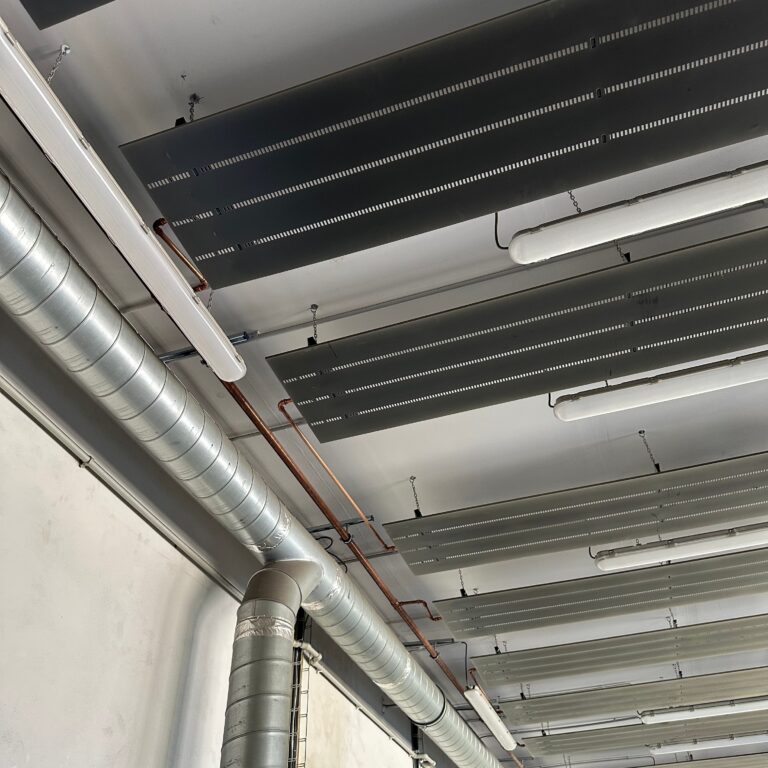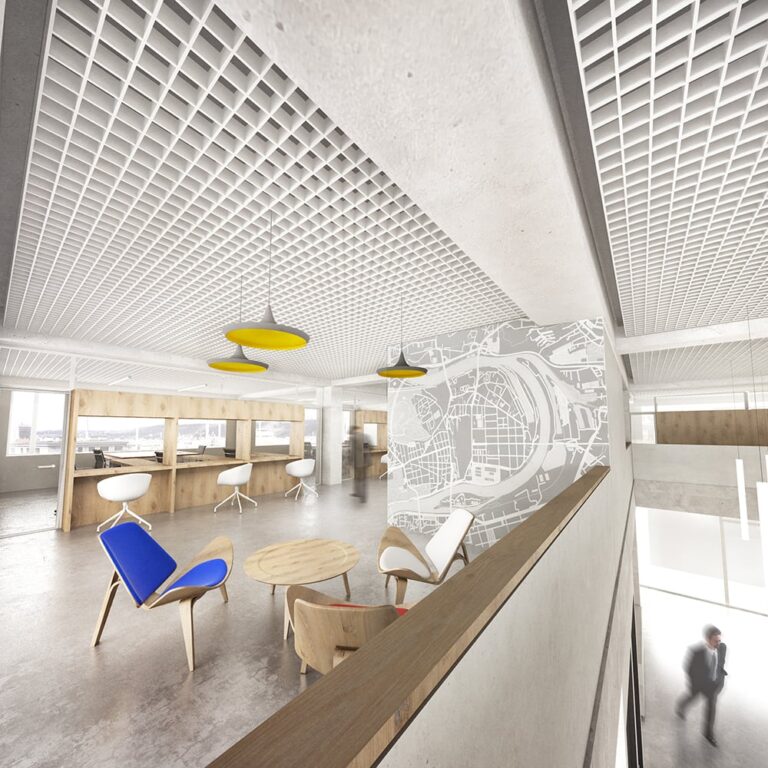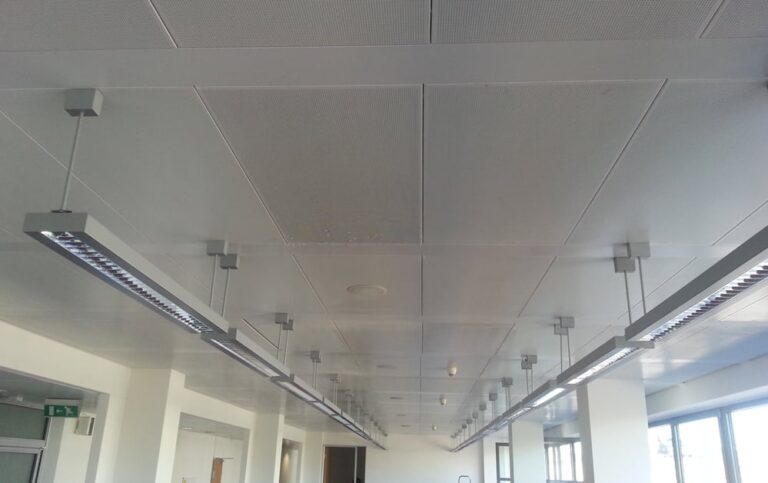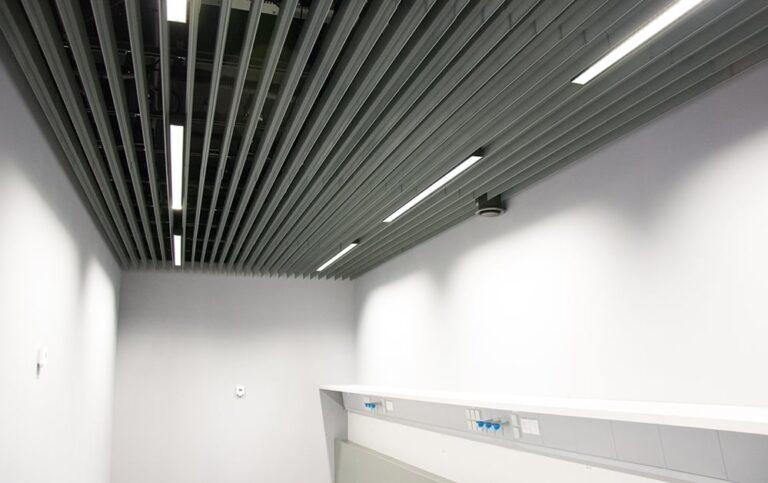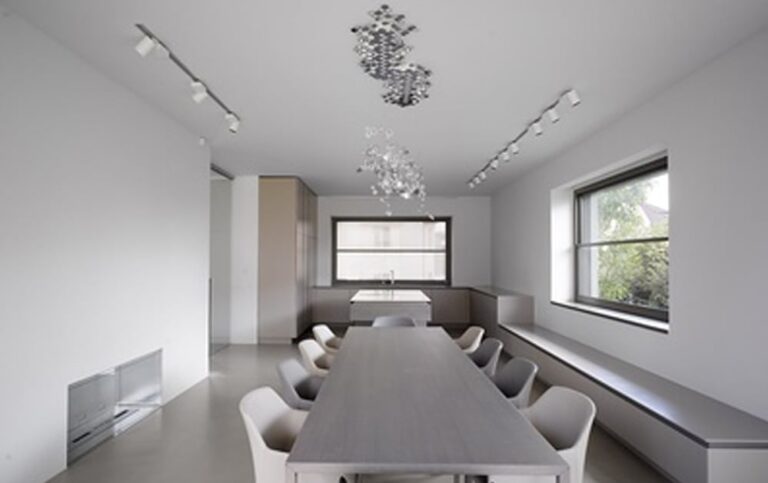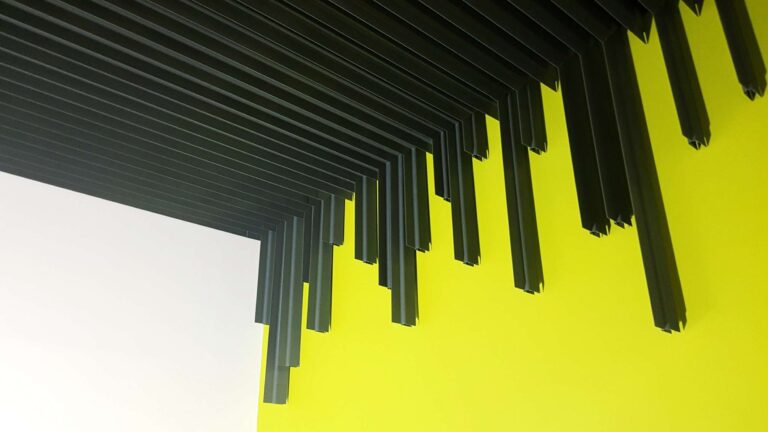Pokud plánujete v domě či objektu rekonstrukci a rádi byste jejím prostřednictvím snížili významně náklady na provoz domu, je to pravý moment kdy zvážit pořízení topně chladících stropů. Kromě toho, že budete moci začít využívat všech benefitů popsaných výše, může vás zaujmout také to, že většina stropních systémů se dá montovat do sádrokartonových podhledů a není tedy nutno například likvidovat stávající podlahu či jinak drasticky zasahovat do interiéru domu.
Stropní topení a chlazení
- Úspora až 45% na energiích
- Nejkomfortnější řešení bez průvanu
- Volná dispozice interiéru
Ceny již od 1999,- Kč/m²
Sálání jako přirozená tepelná energie
Komfortní vnitřní klima by se dalo charakterizovat příjemnou vnitřní teplotou bez pocitu průvanu. Jednoduše řečeno je pro vás pobyt v dané místnosti pohodlný, ať již jste v kanceláři, konferenční místnosti, sportovní hale či například hotelovém pokoji. A právě takový pocit vám sálavé topení dokáže navodit.
Sálavé vytápění (záření) je velmi přirozený způsob předávání tepelné energie. Pro lidské oko je takové infračervené záření neviditelné, přesto ho vnímá v podobě tepla.
Intenzita záření je závislá na povrchové teplotě zdroje. Čím vyšší teplota zdroje je, tím je záření intenzivnější a současně získává i větší dosah. Při dosažení dostatečně vysoké intenzity se záření dokonce přesouvá do viditelné části infračerveného spektra a zdroj energie začne svítit. Typickým příkladem je žárovka nebo slunce, které slouží jako zdroj světla a zároveň vyzařují teplo.
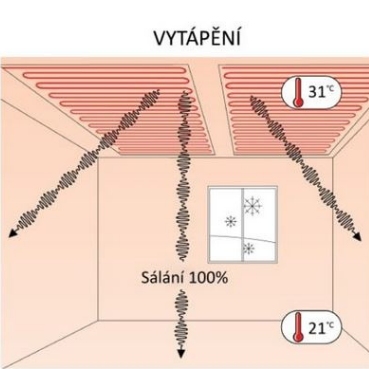
Topné sálavé stropní topení dokáže velice efektivně využit neviditelnou část infračerveného spektra a to u místností s výškou až 30 metrů. Díky své poměrně vysoké povrchové teplotě vyzařují teplo procházející vzduchem až k pevným předmětům v místnosti nebo na povrch lidského těla. Povrch těchto předmětů se poté přirozeně a hlavně rovnoměrněji ohřívá při výrazně nižší spotřebě energie.
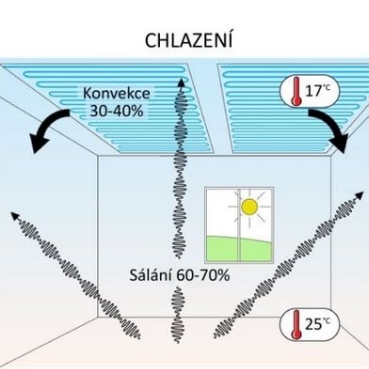
Chladicí sálavé stropní topení funguje na principu konvekce. Samy se „ohřejí“ pouze na teplotu cca 17 °C. A protože předměty (i osoby) v místnosti vyzařují vyšší teplotu, takto ohřátý vzduch pak stoupá vzhůru, kde se ochladí. V místnosti tak vzniká přirozená cirkulace vzduchu bez průvanu.
Jaké jsou hlavní výhody?
- Náš systém topně-chladicích stropů lze použít jak pro vytápění tak i pro chlazení. Není tedy nutné řešit zvlášť esteticky rušící otopné tělesa, nebo ergonomicky nevyhovující fancoily.
- Garantovaná funkčnost 50 let
- Vysoké topné a chladící výkony
- Atraktivní design pro široká architektonická využití
- Snadná montáž
- V místnostech nepřekáží trubky ani radiátory
- Možnost nastavení požadované teploty zvlášť v jednotlivých místnostech
- Možná integrace osvětlení, vzduchotechniky, čidel, reproduktorů apod.
- Výborné akustické vlastnosti při volbě perforace
- Chladicí výkon od 45 až do 350 W/m²
- Topný výkon od 50 až do 140 W/m²
- Okamžitě vnímaný tepelný nebo chladící účinek – rychlá reakční doba od 2,5 minut
- Rovnoměrně rozložené teplo v celém prostoru a po celé výšce budovy
- Ideální kombinovat s obnovitelnými zdroji energie např. s tepelným čerpadlem
- Lze kombinovat s dalšími vzduchotechnickými prvky
- Ve srovnání s podlahovým nebo stěnovým vytápěním může stropní vytápění nerušeně vydávat teplo a není blokováno tlustými koberci nebo velkými kusy nábytku.
- Žádné víření prachu – minimální šíření bakterií a virů, výhoda pro alergiky
- Naprosto tichý provoz a chlazení bez průvanu
- Během chlazení nedochází k vysoušení vzduchu, jak je tomu v případě klasické klimatizace
- Možnost úspory provozních nákladů až 45 %
- Rychlá návratnost počáteční investice (2,5-3,5 roku)
- Žádné další náklady na elektřinu, opravy, údržbu, revize
- Nízké provozní náklady – pro vytápění vám bude stačit ohřívat vodu pouze na 30 °C, což je významně méně než například u klasických radiátorů, kde teplota vody dosahuje obvykle 55 °C. V létě pro chlazení zase není nutno ochlazovat vodu příliš, pro komfortní vychlazení vystačí teplota 18 °C, u klasických klimatizací to přitom bývá 7 °C
Stropní vytápění a chlazení navíc snižuje šíření choroboplodných látek a virů a dle posledních studií je nejlepším epidemickým opatřením proti šíření nákazy virem SARS CoV 2. Pro dodatečnou likvidaci bakterií a virů lze stropní vytápění rozšířit o funkci BION.
Jak vypadají stropní systémy v praxi?
Jaké použít materiály?
Stropní sálavé systémy je možné pořídit v několika materiálových variantách. Materiálové varianty nebo také teplosměnné plochy, které ve vašem interiéru slouží jako výměník energie pro vytápění nebo chlazení tím, že sálají buď teplo nebo chlad, mají díky své odlišnosti různé výkonové vlastnosti a tepelnou vodivost.
Než se tak pustíte do výběru topně chladícího systému, zvažte, do kterého materiálu bude investice nejvýhodnější. Pro srovnání jsme vybrali ty nejčastější, na které se nás zákazníci ptají. Je to systém vyrobený z plastu, z mědi/hliníku, anebo karbonový (uhlíkový) systém. Kromě společných výhod všech, jako je neviditelnost systémů v interiéru a komfortní funkčnost bez jakéhokoliv hluku, disponují rozdílnými materiálovými vlastnostmi, které jsou zmíněny níže.
Varianty stropních systémů
Systém s plastovým výměníkem
Systémově se jedná o plastové potrubí v kombinaci se sádrokartonovou deskou. Potrubí pro rozvod chladu/tepla je buďto vestavěné nebo je instalované nad sádrokartonovou deskou.
Systém je určený pro suchý systém výstavby s rychlou montáží a je vhodný zejména pro renovace. Nevýhodou systému je ale plastové potrubí s problematickou životností. Ta je u tohoto materiálu omezená a závislá na teplotě. Obvykle plasty, ze kterých se vyrábějí stropní výměníky, nemají kyslíkovou bariéru, tudíž se systémy zavzdušňují a kovové části v hydraulice systému korodují. Celý systém se tak musí oddělit výměníkem, na kterém jsou výkonové ztráty a zdroj musí vyrábět o to vyšší teplotu pro vytápění a o to nižší teplotu pro chlazení.
Systém jako takový je vhodný pro méně náročné stavby z hlediska požadavku na výkon a vnitřní komfort. Nezanedbatelná je i otázka recyklace, která v případě plastu není zcela možná.
Systém s kovovým výměníkem
Systém, který je složen z hliníkovo-měděné konstrukce skryté nad sádrokartonovým podhledem, je vhodný pro jakákoliv architektonická řešení. Lze s ním vytvářet také bezespáré celoplošné, nebo i ostrovní stropní podhledy.
Díky tomu, že systém navrhujeme na míru pro konkrétní místnost, není problém s instalací vestavných stropních komponentů. Systém také kombinujeme se speciálními sádrokartonovými deskami se zvýšenou tepelnou vodivostí a možností absorpce hluku. Díky tomu, že je složen ze sádrokartonových desek a kovové konstrukce, je v tomto systému zaručen lepší výkon a tepelná vodivost než u systému s plastovým výměníkem.
Systém je velice flexibilní, je možné ho přizpůsobit na míru představám zákazníka a požadavkům každé jednotlivé místnosti. Hodí se do objektů, kde je vyžadován vysoký výkon i komfort vnitřního ovzduší. Navíc je i po konci životnosti materiál možno spolehlivě recyklovat pro další rovnocenné využití.
Systém s karbonovým výměníkem
Tento pokrokový systém pro celoplošné stropní podhledy využívá výhod výše popsaného kovového systému a posouvá hranice výkonu ještě dál. Výhodou je jeho konstrukční lehkost v kombinaci s vysokým výkonem a výbornými akustickými vlastnostmi.
Stropní podhled je v tomto případě složen z karbonové desky se zabudovaným měděným potrubím pro rozvod tepla a chladu. Zásadní rozdíl od systému s plastovým výměníkem je zde ovšem v materiálu rozvodů. Měděná potrubí disponují dlouhou životností a skvělou vodivostí, která je navíc podpořena skvělými vlastnostmi karbonové desky. Systém s karbonovým výměníkem se řadí díky svým vlastnostem ke špičce v dostupných řešení na trhu, od čehož se ale také odvíjí jeho vyšší pořizovací cena. I v tomto případě platí, že se jedná o výborně recyklovatelné materiály.
Srovnání výkonů a tepelné vodivosti materiálů
Pokud bychom chtěli vlastnosti jednotlivých materiálů v systému vyčíslit, můžeme se krátce zmínit o jejich výkonnosti a vodivosti. Z hlediska chladícího výkonu vám nejlépe poslouží měděný materiál, vůči němu se na druhé místo řadí hliník s výkonem o cca 37 % nižším a dále plast, jehož výkon je až o 60 % nižší než u mědi.
Při výběru vhodného stropního systému nás však zajímá taková tepelná vodivost, která představuje v podstatě rychlost, jakou se teplo šíří a přenáší z jedné zahřáté části materiálu do jiné. Uvádí se symbolem λ (lamda) a jednotkou je W/m.K. Pro srovnání (při 20 °C):
- tepelná vodivost mědi je 395 W/m.K,
- tepelná vodivost hliníku je 229 W/m.K,
- tepelná vodivost plastu je 0,18 W/m.K.
Kam se topně chladící stropy hodí?
- Sportovní, průmyslové, výrobní a další velké haly a objekty
- Kancelářské budovy, kongresové prostory, obchody, školy, nemocnice
- Byty, rodinné domy a menší objekty s vysokým nárokem na estetické provedení a vnitřní komfort
- Ideální při rekonstrukcí bytů, bytových domů, kancelářských a technologických prostor
Úspora energie
Topně chladící stropy jsou velice úsporné na spotřebu energie. Díky nízkým provozním teplotám se vám počáteční investice vrátí za několik let.
Čeká vás rekonstrukce?
Jednoduchá a snadná montáž
Ideální pro historické budovy
Řešíte-li rekonstrukci starých nebo památkově chráněných budov, budete moci zachovat krásné podlahy. Navíc díky topně chladícím stropním systémům budete mít naprostou volnost při návrhu interiérového designu.
Stropní topně-chladící prvky
Obnovitelné zdroje energie pro vytápění a chlazení domů čerpané ze země, vzduchu, vody nebo jejich chytrou kombinací. Technologie pro trvale udržitelný ekosystém, které šetří peníze.
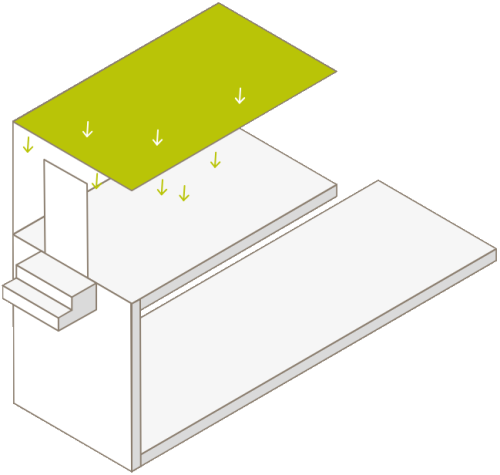
BATISO PLUS
Batiso je technologie umístěná v železobetonovém skeletu domu ve kterém obíhá temperované topně-chladicí médium. Lze jej umístit do stropů, podlah i do stěn. Skelet domu akumuluje teplo nebo chlad a s časovou prodlevou jej vyzařuje do obytných prostor. Prodlevu lze zkrátit speciální konstrukcí.
Batiso (Plus) jsou pak betonové topně-chladicí prvky rozšiřující systém Batiso (TABS). Jedná se zónové prvky instalované např. podél fasády. Tato technologie umožňuje individuální regulaci teploty v místnosti.
Výhody
Výhodou jsou interiéry bez stropních podhledů, možnost regulace teploty v místnosti v kombinaci s vysokým tepelným komfortem.
Pro větší efektivitu topného a chladicího výkonu lze kombinovat se systémem Velum.
Určení
Určeno pro nové vícepodlažní stavby s železobetonovým skeletem. Ideální kombinovat s technologií Batiso (TABS). Vhodné pro interiéry s pohledovým šalovaným betonem.
Určeno pro nové vícepodlažní stavby s železobetonovým skeletem. Ideální kombinovat s geotermálními zdroji tepelné energie.
BATISO (TABS)
Batiso jsou PEX trubkové registry umístěné ve středu neutrální zóny železobetonového skeletu domu. Tvoří tak systém pro sálavé vytápění a chlazení budov, který využívá akumulační schopnosti betonu.
Batiso je technologie umístěná v železobetonovém skeletu domu ve kterém obíhá temperované topně-chladicí médium. Lze jej umístit do stropů, podlah i do stěn. Skelet domu akumuluje teplo nebo chlad a s časovou prodlevou jej vyzařuje do obytných prostor.
Batiso lze zabudovat v horizontálním i vertikálním směru. Působení v prostoru přichází s časovou odezvou a je závislé na stavu akumulace a stávající teplotě v prostoru. Prodlevu lze zkrátit speciální konstrukcí.
Individuální řízení teploty v místnostech je možné jen prostřednictvím přídavného recirkulačního systému.
Systém Batiso TABS je určen pro nové vícepodlažní stavby s železobetonovým skeletem a interiéry s pohledovým šalovaným betonem. Ideální kombinovat s geotermálními zdroji energie.
Výhody
Výhodou je jeho bezúdržbový systém, relativně nízká investice a neviditelnost v interiéru v kombinaci s vysokým tepelným komfortem.
Určení
Určeno pro nové vícepodlažní stavby s železobetonovým skeletem a interiéry s pohledovým šalovaným betonem. Ideální kombinovat s geotermálními zdroji tepelné energie.
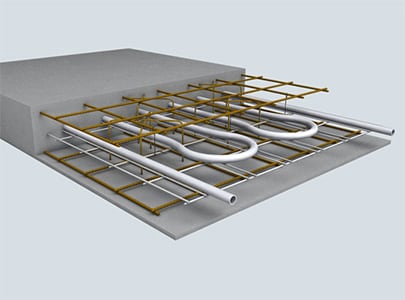
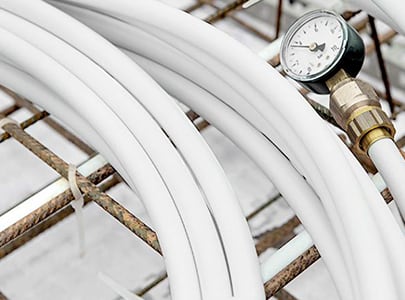
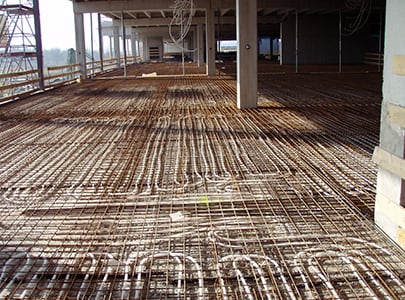
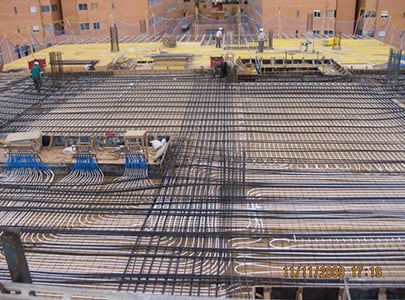
BATISO AIR
Batiso Air je systém, který umožňuje integrovat vzduchotechnické rozvody ve stropních betonových konstrukcích. Přívod vzduchu je distribuován touto cestou k vzduchovým vyústěním, integrovaným v podlaze. Technologie dovoluje distribuci čerstvého vzduchu do místností bez stropního podhledu.
Výhodou jsou interiéry bez stropních podhledů, optimální distribuce vzduchu v budově, hygienická nezávadnost v kombinaci s vysokým tepelným komfortem.
Určeno pro nové vícepodlažní stavby s železobetonovým skeletem. Ideální kombinovat s technologií Batiso (TABS).

CARBON A
Carbon A je kovová kazeta upevněná pod stropem v pravidelném rastru a vytváří celoplošné kazetové stropní podhledy. Design lze individualizovat v široké škále barevností a velikostí perforace. Uvnitř kazety je karbon-měděné vysokovýkonné topně-chladicí zařízení.
Výhodou je jeho střídmý a kompaktní design v kombinaci s vysokým výkonem a výbornými akustickými vlastnostmi. V prostorách se systémem Carbon A nejsou nutná jakákoliv další otopná nebo chladicí tělesa.
Kazety systému Carbon A jsou vyráběny v několika rozměrech. V částech kde jsou umístěny vestavné stropní komponenty (osvětlení, audio reproduktory, stínící technika…) se instalují neaktivní kazety.
Uvnitř kazety je karbon-měděné vysokovýkonné topně-chladicí zařízení. Vhodné pro použití se zdroji geotermální energie.
- jedno řešení pro vytápění i chlazení – médiem je voda,
- bezprůvovanový systém (funguje na principu sálání),
- neomezující flexibilní design s mnoha možnosti,
- dokáže pokrýt celou plochu stropu a integrovat do sebe další prvky (osvětlení aj.),
- vysokovýkonný systém,
- v nabídce je několik typizovaných rozměrů kazet,
- světlá výška dílce 30/40 mm,
- akustika αW = 0,7 (dle EN ISO 11654),
- výkon pro chlazení 94W/m2 ∆t 8K / vytápění 133W/m2 ∆t 15K (dle EN 140 37).
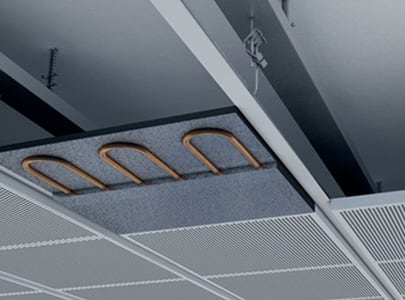
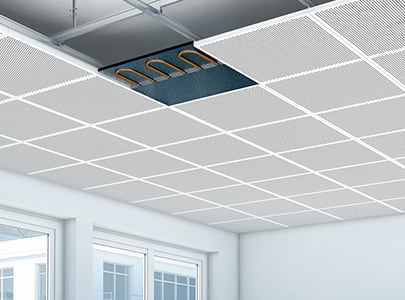
CARBON S
Systém Carbon S se skládá ze standartní zavěšené nosné konstrukce z karbonových desek s integrovaným topně-chladicím zařízením. Lze s ním vytvářet bezespáré celoplošné, nebo ostrovní stropní podhledy.
Výhodou systému je jeho neviditelnost v interiéru, vysoký výkon a komfortní funkčnost bez jakéhokoliv hluku. Carbon S systém nahrazuje jakákoliv další nevzhledná otopná nebo chladicí tělesa.
Desky systému Carbon S jsou vyráběny v několika typizovaných rozměrech. V částech, kde jsou umístěny vestavné stropní komponenty (osvětlení, audio reproduktory, stínící technika…), se instalují standartní sádro-kartonové desky.
- jedno řešení pro vytápění i chlazení – médiem je voda,
- celoplošené (bez viditelných spár) nebo ostrovní podhledy,
- bezprůvovanový systém (funguje na principu sálání),
- neomezující flexibilní design s mnoha možnosti, variabilní pro všechny typy prostor,
- výkon pro chlazení 100W/m2 ∆t 8K / vytápění 145W/m2 ∆t 15K (dle EN 140 37),
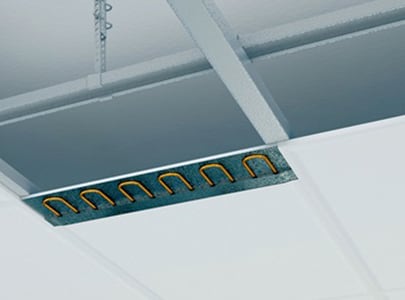
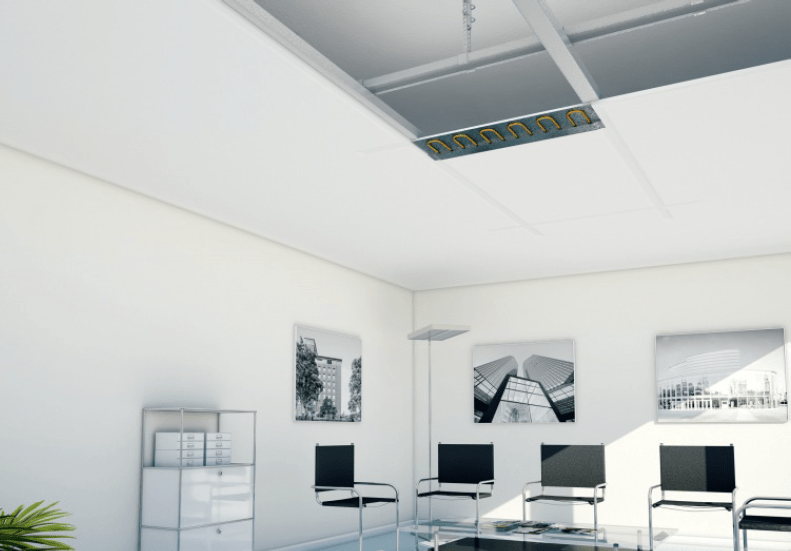
COMPACT LINE
Systém pro stropní chlazení prostor. Compactline je chladicí trám zavěšený pod stropem, který využívá principu přirozené cirkulace ochlazeného vzduchu v místnosti.
Díky modulární technologii a variabilnímu tvaru jsou chladicí trámy vhodné jak pro novostavby, tak pro instalace v již existujících budovách.
Zařízení Compactline pracuje na principu přirozené cirkulace teplého a ochlazeného vzduchu. Teplý vzduch z místnosti je shora nasáván do zařízení a proudí přes tepelný výměník, kde se ochladí, stane se těžším než vzduch v okolí a pomalu proudí dolů.
Výběr možný ze čtyř produktových designů v barvě dle Vašich požadavků.
Díky modulární technologii a variabilnímu tvaru jsou chladicí trámy vhodné jak pro novostavby, tak pro instalace v již existujících budovách.
- jedno řešení pro vytápění i chlazení – médiem je voda,
- bezprůvovanový systém (funguje na principu sálání),
- modulární technologie pro novostavby i rekonstrukce,
- rozměry v šířkách 155/305/455/605mm (délka max. 4m),
- světlá výška dílce 100/150mm,
- výkon pro chlazení závisí na zvoleném typu 87-337W/m2 ∆t 8K (Dle EN 140 37).
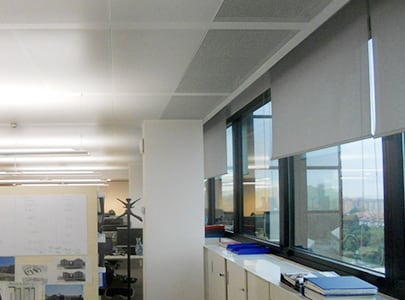
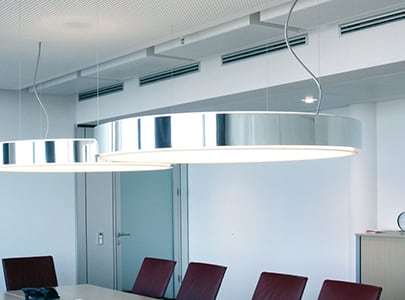
OPTI Y
Nízkoteplotní systém pro sálavé stropní vytápění a chlazení prostor. Opti Y je podvěšen pod stropem na speciální nosné konstrukci a řadou hliníkových profilů vytváří otevřený podhled.
Komfortní bezprůvanové řešení pro budovy dodáváme ve dvou základních provedeních dle Vašich estetických požadavků:
- pro otevřený (přiznaný) podhled,
- pro skrytou montáž nad podhled.
Mezi hliníkové profily otevřeného systému Opti Y je možné instalovat další závěsné stropní technologie (osvětlení, detektory kouře…). Systém lze individualizovat eloxováním, nebo lakováním v barevnosti na přání.
Výhody
Výhodou je komfortní bezprůvanové řešení v kombinaci s vysokým výkonem a maximální možností estetické individualizace. Z hliníkových profilů Opti Y lze sestavit vizuálně celistvou plochu podhledu.
V prostorách se systémem Opti Y nejsou nutná jakákoliv další otopná nebo chladicí tělesa. Díky otevřenému podhledu je ale možné systém Opti Y kombinovat se vzduchotechnikou.
- jedno řešení pro vytápění i chlazení – médiem je voda,
- bezprůvovanový systém (funguje na principu sálání),
- dokáže pokrýt celou plochu stropu,
- snadná instalace závěsných stropních prvků (osvětlení, detektory kouře aj.),
- vysoký výkon a maximální možnost exterické individualizace,
- světlá výška systému 170/180 mm,
- výkon pro chlazení 250W/m2 ∆t 10K / vytápění 120W/m2 ∆t 15K (Dle EN 140 37).
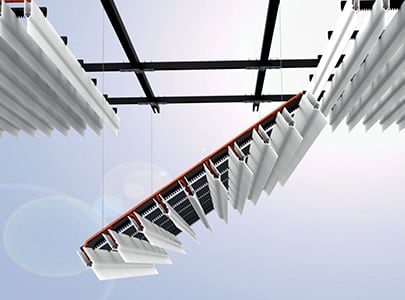
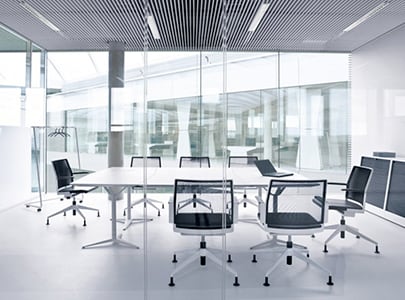
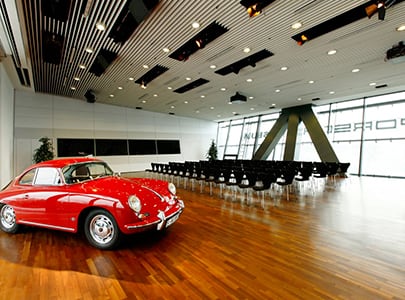
Realizace
RENO
Systém Reno je sádrokartonová deska standartních rozměrů, ve které je vestavěné potrubí pro rozvod chladu a tepla. Lze s ním vytvářet bezespáré celoplošné, nebo ostrovní stropní podhledy. Systém je určen pro sálavé stropní vytápění a chlazení prostor, je vhodný zejména pro renovace. Sálavé vytápění představuje nejúčinnější způsob, jak vytvořit pohodlné a příjemné prostředí v každé domácnosti.
Výhodou systému je jeho neviditelnost v interiéru a komfortní funkčnost bez jakéhokoliv hluku. Reno je určený pro suchý systém výstavby s rychlou montáží vhodný zejména pro renovace.
- Výkon pro chlazení 47 W/m2 ∆t 10K / vytápění 55 W/m2 ∆t 15K (Dle EN 140 37)
Protože je systém Reno modulově univerzální, není do něj možné instalovat vestavné stropní komponenty (osvětlení, audio reproduktory, stínící technika…).
Konstrukce systému Reno je přizpůsobena konstrukci suché výstavby, nikoliv však k vestavěným instalacím dalších technologií v prostoru a obtížné prostorové geometrii.
- Matriál systémové sádro-kartonové desky je vyztužen skelným vláknem.
- Systém SDK podhledu
- Médiem pro vytápění a chlazení je voda
- Rozměr vestavěného potrubí 9.9 x 1.1 mm
- Tloušťka desky 15mm
- Výkon pro chlazení 47 W/m2 ∆t 10K / vytápění 55 W/m2 ∆t 15K (Dle EN 140 37)
Instalace
Instalace Reno systému je obdobná jako u standartního sádrokartonového stropu. Desky však nelze krátit dle potřeby, ale je nutné předem vytvořit plány k pokládce. Se systémem Reno lze vytvářet bezespáré celoplošné, nebo ostrovní stropní podhledy.
Specifika
- není do něj možné instalovat vestavné stropní komponenty (osvětlení, audio reproduktory, stínící technika…).
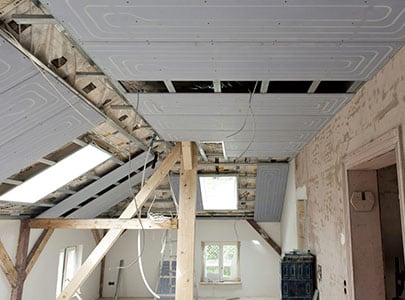
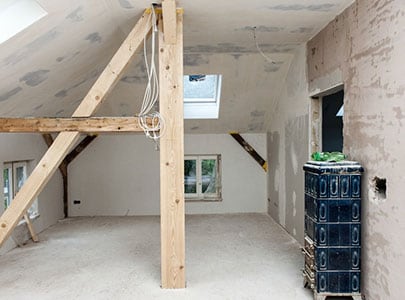
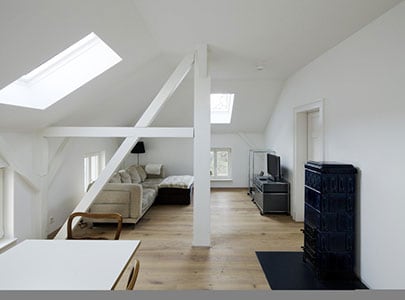
SOFTLINE 4
Systém pro sálavé stropní vytápění a chlazení prostor a slouží jako komfortní bezprůvanové řešení pro budovy. Softline 4 je podvěšen pod stropem a řadou hliníkových profilů vytváří ostrovní podhled. Produkt lze individualizovat eloxováním, nebo lakováním v barevnosti na přání.
Výhodou je jeho lehký a členitý design v kombinaci s vysokým výkonem a kvalitním zpracováním. Možnost z hliníkových profilů Softline 4 sestavit téměř celistvou plochu podhledu. V prostorách se systémem Softline 4 nejsou nutné jakákoliv další otopná nebo chladicí tělesa.
Hliníkové profily systému Softline 4 jsou dodávány v rozměrech na míru (max. délka 4m).
- jedno řešení pro vytápění i chlazení – médiem je voda,
- bezprůvovanový systém (funguje na principu sálání),
- neomezující flexibilní design s mnoha možnosti,
- dokáže pokrýt celou plochu stropu a integrovat do sebe další prvky (osvětlení aj.),
- rozměry: šířka profilu 83mm, délka na míru max. 4 m,
- světlá výška systému 77 mm,
- výkon pro chlazení 132-146W/m2 ∆t 10K / vytápění 120-140W/m2 ∆t 15K (Dle EN 140 37),
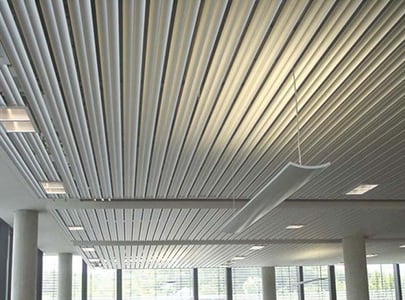
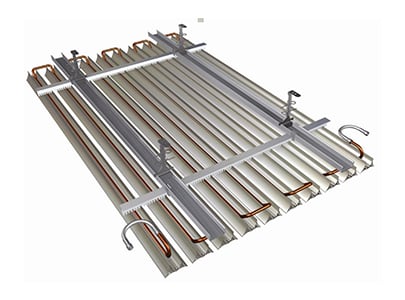
SPEKTRA
Spektra je systém pro sálavé stropní vytápění a chlazení prostor, který nabízí komfortní bezprůvanové řešení a atraktivní vzhled budov.
Spektra je kovová kazeta upevněná pod stropem v pravidelném rastru a vytváří celoplošné kazetové stropní podhledy. Uvnitř kazety je vlepené, nebo magneticky přichycené topně – chladicí zařízení sestávající z měděných rozvodů média a hliníkových profilů roznášející tepelnou energii.
Výhodou je dostupné řešení v kombinaci s vysokým výkonem a výbornými akustickými parametry. V rámci návrhu je možné kombinovat aktivní a neaktivní části podhledu.
Vhodné pro použití se zdroji geotermální energie.
Sálavý stropní systém Spektra lze kombinovat se systémy QUELLO, k dosažení ještě efektivnějších řešení vytápění a chlazení pro Váš projekt.
Výhody
Výhodou je komfortní bezprůvanové prostředí v kombinaci s vysokým výkonem a výbornými akustickými vlastnostmi. V prostorách se systémem Spektra nejsou nutná jakákoliv další otopná nebo chladicí tělesa.
- jedno řešení pro vytápění i chlazení – médiem je voda,
- bezprůvovanový systém (funguje na principu sálání),
- neomezující flexibilní design s mnoha možnosti,
- dokáže pokrýt celou plochu stropu a integrovat do sebe další prvky (osvětlení aj.),
- díky perforaci má vynikající akustické vlastnosti,
- možnost kombinace se vzduchotechnickým zařízením,
- rozměry kazet jsou dané na míru, ze železa nebo hliníku,
- světlá výška dílce 30/40/50 mm,
- akustika αW = 0,6 (dle EN ISO 11654),
- výkon pro chlazení 84W/m2 ∆t 8K / vytápění 130W/m2 ∆t 15K (dle EN 140 37).
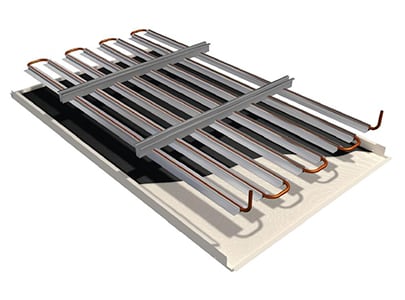
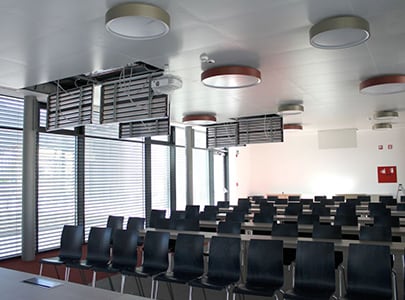
UNI
Systém UNI přináší unikátní způsob sálavého stropního vytápění a chlazení prostor. Sálavé vytápění představuje nejúčinnější způsob, jak vytvořit pohodlné a příjemné prostředí v každé domácnosti.
Systém UNI je skrytý nad sádrokartonovým podhledem (je součástí nosné konstrukce sádrokartonového stropu), což umožňuje jeho použití pro jakákoliv architektonická řešení. Lze s ním vytvářet bezespáré celoplošné nebo ostrovní stropní podhledy.
Zákrytem pro systém UNI jsou speciální sádro-kartonové desky se zvýšenou tepelnou vodivostí. Použitím perforovaných desek s vrstvou akustické textilie lze docílit akusticky účinného provedení.
Výhody
Výhodou systému je jeho neviditelnost v interiéru, komfortní funkčnost bez jakéhokoliv hluku a v neposlední řadě flexibilita návrhu. UNI systém nahrazuje jakákoliv další nevzhledná otopná nebo chladicí tělesa.
- jedno řešení pro vytápění i chlazení – médiem je voda,
- bezprůvovanový systém (funguje na principu sálání),
- neomezující flexibilní design s mnoha možnosti,
- dokáže pokrýt celou plochu stropu a integrovat do sebe další prvky (osvětlení aj.),
- světlá výška systému 70mm,
- akustika αW = 0,6 (dle EN ISO 11654),
- výkon pro chlazení 50-80W/m2 ∆t 10K / vytápění 63-92W/m2 ∆t 15K (dle EN 140 37),
- úspora energie až 45 %,
Díky tomu, že systém UNI navrhujeme na míru pro konkrétní místnost, není problém s instalací vestavných stropních komponentů (osvětlení, audio reproduktory, stínící technika…).
Systém UNI kombinujeme se speciálními sádrokartonovými deskami se zvýšenou tepelnou vodivostí a možností absorpce hluku.
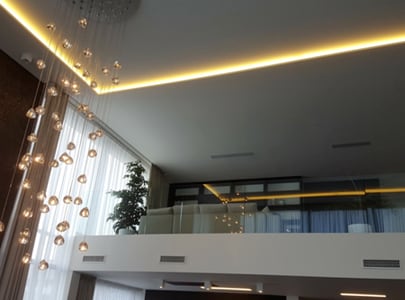
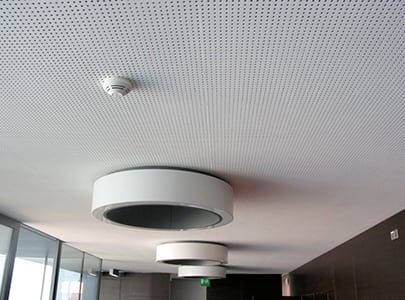
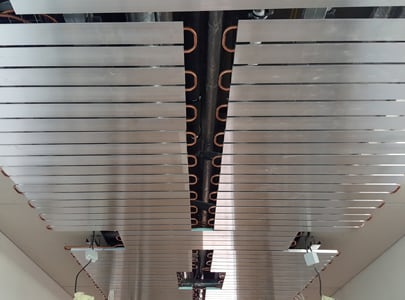
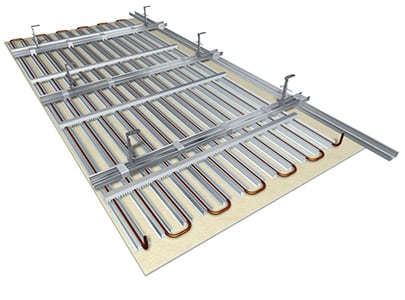
SPEKTRA O
Spektra O je kovová kazeta zavěšená pod stropem a vytváří ostrovní kazetové stropní podhledy. Design lze individualizovat v široké škále barevností a velikostí perforace. Je to ideální nízkoteplotní systém pro sálavé stropní vytápění a chlazení prostor.
Uvnitř kazety jsou vlepené, nebo magneticky přichycené topně – chladicí zařízení sestávající z měděných rozvodů média a hliníkových profilů roznášející tepelnou energii.
Sálavý stropní systém Spektra O lze kombinovat se systémy QUELLO, k dosažení ještě efektivnějších řešení vytápění a chlazení pro Váš projekt. Vhodné pro použití se zdroji geotermální energie.
Výhody
Výhodou je jeho střídmý a kompaktní design v kombinaci s vysokým výkonem, výbornými akustickými vlastnostmi a prostorovou variabilitou, které nabízí možnost individualizace v široké škále barevností a velikostí perforace. V prostorách se systémem Spektra O nejsou nutná jakákoliv další otopná nebo chladicí tělesa.
- kovové nebo hliníkovépanely zavěšené pod stropem (vlepené, navrtané nebo magneticky uchycené),
- jedno řešení pro vytápění i chlazení – médiem je voda,
- bezprůvovanový systém (funguje na principu sálání),
- neomezující flexibilní design s mnoha možnosti, ze železa nebo hliníku,
- různé typy perforací,
- výkonný systém, možnost využít termálních vlastních vlastností masy betonu,
- rozměry kazet jsou na míru projektu,
- světlá výška dílce 30/40 mm,
- akustika αW = 0,8 (dle EN ISO 11654),
- výkon pro chlazení 101W/m2 ∆t 8K / vytápění 153W/m2 ∆t 15K (dle EN 140 37).
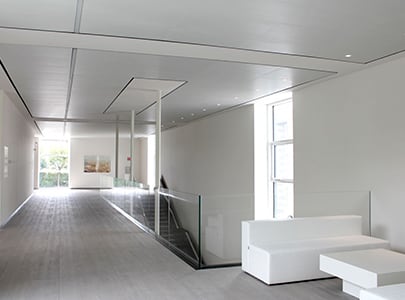
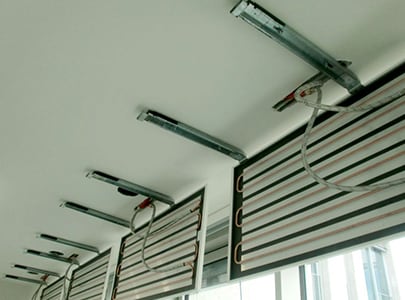
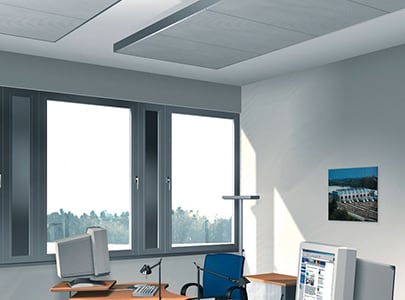
VELUM
Systém pro sálavé stropní vytápění a chlazení prostor. Velum je podvěšen pod stropem a vytváří ostrovní stropní pohledové dílce, které rovnoměrně sálají do celého prostoru. Nabízí možnost z dílců sestavit téměř celistvou plochu podhledu.
Výhody
Výhodou je komfortní bezprůvanové prostředí v kombinaci s vysokým výkonem a velmi dobrými akustickými parametry. V prostorách se systémem Velum nejsou nutné jakákoliv další otopná nebo chladicí tělesa.
Sálavé dílce Velum lze kombinovat se systémem Contec, k dosažení ještě efektivnějších řešení vytápění a chlazení pro Váš projekt. Tím lze vytvořit tzv. hybridní systém, který využívá termálních vlastností stropní
masy betonu.
- jedno řešení pro vytápění i chlazení – médiem je voda,
- bezprůvovanový systém (funguje na principu sálání),
- neomezující flexibilní design s mnoha možnosti,
- tenký design – světlá výška dílce 30mm, realizace z železa nebo hliníku,
- možnost ostrovních nebo celoplochých řešení,
- možnost využití termální stropní masu betonu,
- rozměry na míru (max. 1,3 x 5m),
- akustika αW = 0,8 (dle EN ISO 11654),
- výkon pro chlazení 112W/m2 ∆t 8K / vytápění 187W/m2 ∆t 15K (dle EN 140 37).
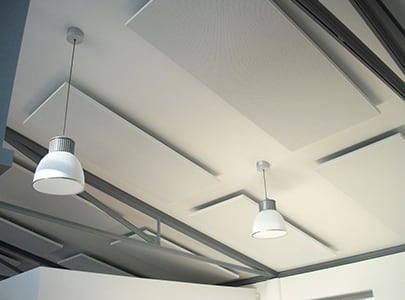
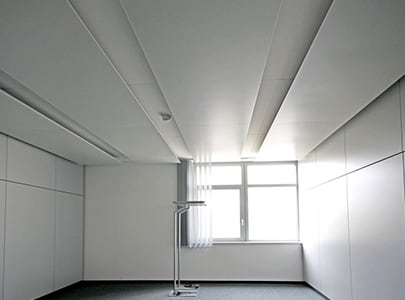
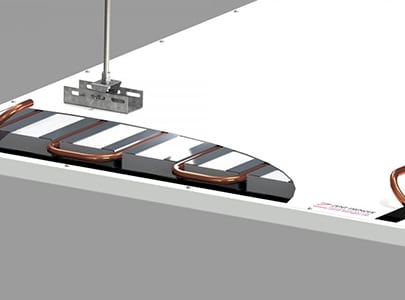
WOOD
Systém pro sálavé stropní vytápění a chlazení. Komfortní bezprůvanové řešení vytápění budov. Wood je přírodní sádrovláknitý panel s finálním povrchem dřevěné dýhy. Panely jsou upevněny pod stropem v pravidelném rastru a vytváří celoplošné bezespáré stropní podhledy.
Vzhled lze individualizovat v široké škále dřevinných dekorů. Výhodou je jeho exkluzivní design v kombinaci s výbornými akustickými vlastnostmi.
V prostorách se systémem Wood nejsou nutná jakákoli další otopná nebo chladicí tělesa. Panely systému Wood jsou vyráběny v několika rozměrech.
- jedno řešení pro vytápění i chlazení – médiem je voda,
- bezprůvovanový systém (funguje na principu sálání),
- neomezující flexibilní design s mnoha možnosti s dekorem pravého dřeva,
- do podhledu lze umístit vestavné stropní komponenty (osvětlení, audio reproduktory,stínící technika…),
- výkon pro chlazení 56W/m2 ∆t 8K (Dle EN 140 37),
- akustický útlum αW = až 0,45 (EN ISO 11654),
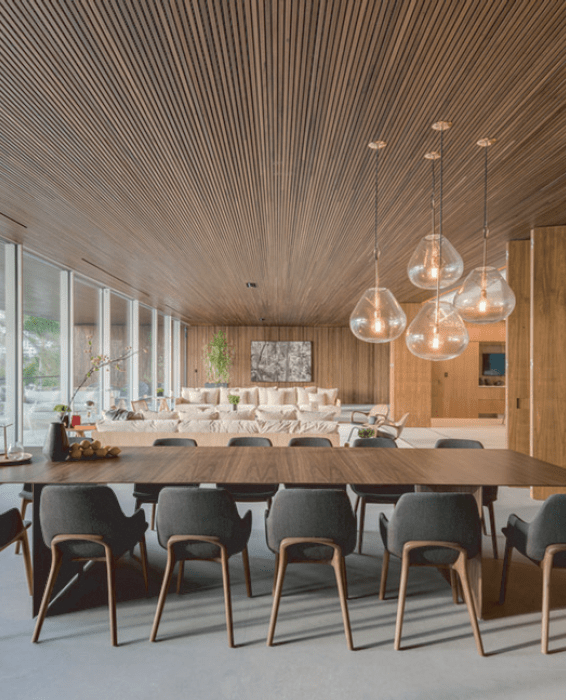
Porovnání stropních systémů
| Systém | Výkon pro chlazení | Výkon pro topení | Akustický utlum |
|---|---|---|---|
| UNI | 50-80W/m2 (∆t 10K) | 63-92W/m2 (∆t 15K) | αW = až 0,45 |
| WOOD | 56W/m2 (∆t 8K) | 90 W/m² (∆t 15K) | αW = 0,6 |
| CARBON S | 100W/m2 (∆t 8K) | 145W/m2 (∆t 15K) | - |
| CARBON A | 94W/m2 (∆t 8K) | 133W/m2 (∆t 15K) | αW = 0,7 |
| Reno | 47 W/m2 (∆t 10K) | 55 W/m2 (∆t 15K) | - |
| COMPACTLINE | 87-337W/m2 (∆t 8K) | - | |
| OPTI Y | 250W/m2 (∆t 10K) | 120W/m2 (∆t 15K) | - |
| SOFTLINE | 132-146W/m2 (∆t 10K) | 120-140W/m2 (∆t 15K) | - |
| SPEKTRA | 84W/m2 (∆t 8K) | 30W/m2 (∆t 15K) | αW = 0,6 |
| SPEKTRA O | 101W/m2 (∆t 8K) | 153W/m2 (∆t 15K) | αW = 0,8 |
| Velum | 112W/m2 (∆t 8K ) | 187W/m2 (∆t 15K) | αW = 0,8 |
FAQ
Jak dlouho trvá instalace a jak probíhá?
Doba instalace stropního sálavého vytápění závisí velikosti a typu budovy, stavu stávajícího stropu, složitosti systému. Celkově může instalace stropního sálavého vytápění trvat přibližně 5 až 10 dní, v závislosti na konkrétních podmínkách a rozsahu práce. U složitějších projektů nebo při nutnosti dalších stavebních úprav může doba instalace trvat déle.
Jaké jsou možnosti údržby a čištění stropu s ohledem na zachování efektivity vytápění?
Stropní sálavé systémy jsou bezúdržbové a není potřeba o ně nijak zvlášť pečovat. Je samozřejmě vhodně sledovat stav kapaliny, která koluje v systému, ale jinak není třeba o systém nijak pečovat.
Může být topně chladící strop integrován s existujícím topným systémem v mém domě?
Ano, stropní systémy lze integrovat na většinu topných systémů. Napište nám, rádi vám poradíme a zkonzultujeme možnosti.
Jaké jsou možnosti ovládání teploty a regulace vytápění u topně chladících stropů?
TODO
Jsou k dispozici různé možnosti povrchové úpravy s ohledem na estetiku a design?
Jak můžete vidět výše na stránce, designové možnosti stropních systémů jsou opravu široké – od kovových (hliník nebo železo) po plastové a je také možné mít designové z pravého dřeva. Záleží čistě na vás, vašich požadavcích na designové, tepelné a akustické vlastnosti.
Proč do toho jít s námi?
Je na nás spolehnutí
Jsme na trhu přes 15 let a máme bohaté zkušenosti s malými i velkými projekty. Naši klienti jsou velké nadnárodní společnosti, firmy a jednotlivci.
- Vyřídíme za vás vše, od papírů až po realizaci
- Díky bohatému seznamu dodavatelů vám najdeme to nejlepší řešení
Máte u nás kompletní servis
- Napište nám, jaké řešení by vás přesně zajímalo a jak vypadá budova.
- Spojíme se a zeptáme se vás na další důležité detaily.
- Získáme od dodavatelů návrhy a cenové nabídky.
- Doporučíme vám tu, která je v hodná přesně pro vaši lokalitu.
- Pohlídáme realizaci přímo na místě, aby vše proběhlo podle plánu.
- I po skončení zůstaneme v kontaktu.


